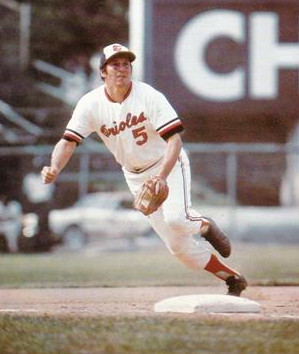Third baseman
Third baseman is a position in baseball and softball played by the fielder stationed near the third base, which is one of the four bases that must be touched by a baserunner in order to score a run. The third baseman's primary responsibility is to defend the area near third base, a position that requires quick reflexes, strong arm strength, and the ability to field ground balls efficiently. Due to the nature of most batters hitting the ball to the opposite field, right-handed batters often hit the ball towards third base, making the position one of the most challenging on the field.
Responsibilities[edit | edit source]
The primary duty of a third baseman is to field ground balls hit towards third base and make accurate throws to first base to get the batter out. In addition to fielding ground balls, third basemen must also have the agility to field bunts and make quick decisions on whether to throw to first base or attempt to tag a runner heading to third base. Third basemen are also involved in fielding line drives and catching pop flies in their vicinity.
Another critical responsibility of the third baseman is to cover third base for any force plays or tag plays that occur at the base. This requires the third baseman to have a good understanding of the game situation, including the number of outs and the positions of baserunners. Third basemen often coordinate with the pitcher and catcher on pickoff moves to third base, attempting to catch baserunners off guard.
Skills Required[edit | edit source]
To excel at third base, a player must possess several key skills:
- Arm Strength: The distance between third base and first base is significant, requiring third basemen to have strong and accurate throwing arms to make outs at first base.
- Quick Reflexes: Balls hit towards third base are often hit very hard, giving the third baseman little time to react. Quick reflexes are essential for fielding ground balls and line drives.
- Agility: The ability to move quickly and change direction is crucial for fielding bunts and making plays on ground balls that require moving to either side.
- Hand-Eye Coordination: Effective fielding requires excellent hand-eye coordination to catch, field, and throw the ball accurately.
- Game Intelligence: Understanding the game situation, knowing the baserunners' speeds, and anticipating bunts or hits in certain situations are vital for making the right plays.
Notable Third Basemen[edit | edit source]
Throughout the history of baseball, several third basemen have stood out for their exceptional skills and contributions to the game. Players like Brooks Robinson, known for his defensive prowess, and Mike Schmidt, celebrated for his power hitting and defense, have set high standards for future generations. More recent stars include Nolan Arenado and Manny Machado, who are both known for their all-around abilities at third base.
In Softball[edit | edit source]
The role of the third baseman in softball is similar to that in baseball, with the player covering the area near third base and possessing similar skills, such as quick reflexes and strong arm strength. However, due to the smaller field size and the faster pace of the game in softball, the third baseman may have even less time to react to batted balls, increasing the importance of quick reflexes and agility.
Search WikiMD
Ad.Tired of being Overweight? Try W8MD's physician weight loss program.
Semaglutide (Ozempic / Wegovy and Tirzepatide (Mounjaro / Zepbound) available.
Advertise on WikiMD
|
WikiMD's Wellness Encyclopedia |
| Let Food Be Thy Medicine Medicine Thy Food - Hippocrates |
Translate this page: - East Asian
中文,
日本,
한국어,
South Asian
हिन्दी,
தமிழ்,
తెలుగు,
Urdu,
ಕನ್ನಡ,
Southeast Asian
Indonesian,
Vietnamese,
Thai,
မြန်မာဘာသာ,
বাংলা
European
español,
Deutsch,
français,
Greek,
português do Brasil,
polski,
română,
русский,
Nederlands,
norsk,
svenska,
suomi,
Italian
Middle Eastern & African
عربى,
Turkish,
Persian,
Hebrew,
Afrikaans,
isiZulu,
Kiswahili,
Other
Bulgarian,
Hungarian,
Czech,
Swedish,
മലയാളം,
मराठी,
ਪੰਜਾਬੀ,
ગુજરાતી,
Portuguese,
Ukrainian
Medical Disclaimer: WikiMD is not a substitute for professional medical advice. The information on WikiMD is provided as an information resource only, may be incorrect, outdated or misleading, and is not to be used or relied on for any diagnostic or treatment purposes. Please consult your health care provider before making any healthcare decisions or for guidance about a specific medical condition. WikiMD expressly disclaims responsibility, and shall have no liability, for any damages, loss, injury, or liability whatsoever suffered as a result of your reliance on the information contained in this site. By visiting this site you agree to the foregoing terms and conditions, which may from time to time be changed or supplemented by WikiMD. If you do not agree to the foregoing terms and conditions, you should not enter or use this site. See full disclaimer.
Credits:Most images are courtesy of Wikimedia commons, and templates, categories Wikipedia, licensed under CC BY SA or similar.
Contributors: Prab R. Tumpati, MD


